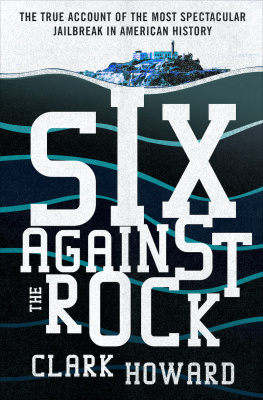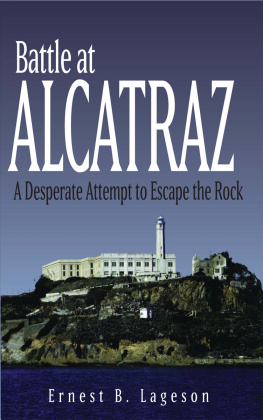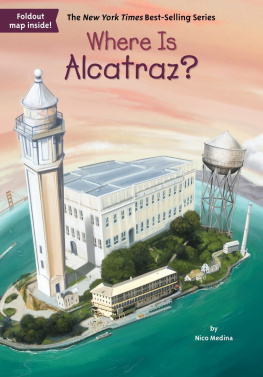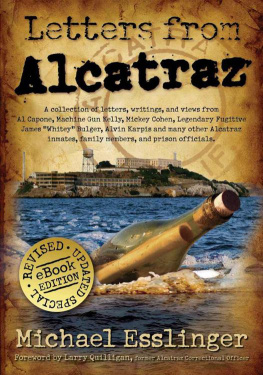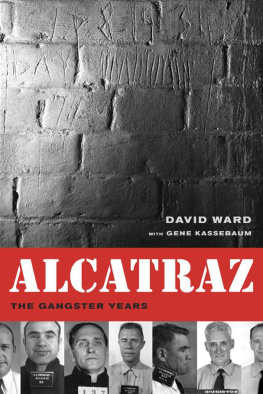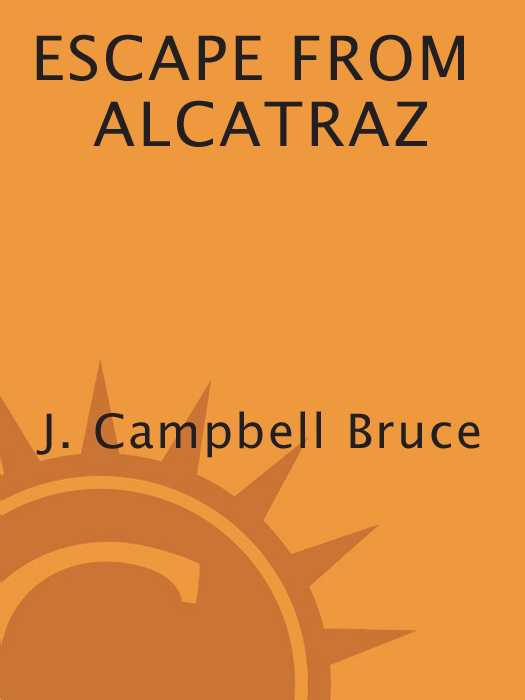Copyright 2005 by the heirs of J. Campbell Bruce
Copyright 1963, 1976 by J. Cambell Bruce
All rights reserved. Published in the United States by Ten Speed Press, an imprint of the Crown Publishing Group, a division of Random House, Inc., New York.
www.crownpublishing.com
www.tenspeed.com
Ten Speed Press and the Ten Speed Press colophon are registered trademarks of Random House, Inc.
Originally published in the United States by McGraw-Hill, New York, in 1963.
Photographs in this book used with permission of the San Francisco History Center, San Francisco Public Library. Photo from the movie Escape from Alcatraz Paramount Pictures; used with permission.
Library of Congress Cataloging-in-Publication Data
Bruce, J. Campbell (John Campbell), 1906
Escape from Alcatraz / J. Campbell Bruce.
p. cm.
Reprint. Originally published: New York : McGraw-Hill, 1963.
1. United States Penitentiary, Alcatraz Island, California. I. Title.
HV9474.A4B7 2005
365.979461dc22
2005002738
eISBN: 978-0-307-81583-5
v3.1
For Bianca,
who did time on this rock.
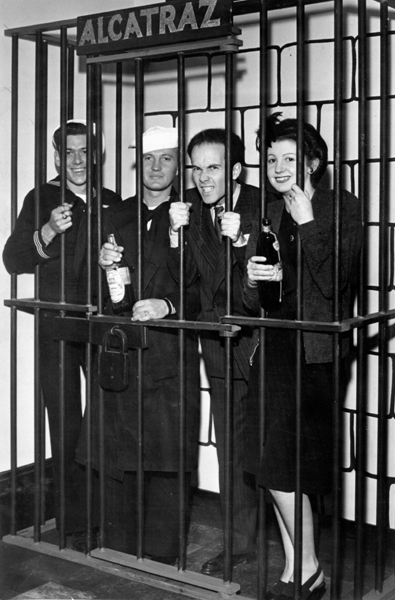
Group posing in a fake prison cell labeled Alcatraz, 1944.
Title page: Aerial view of Alcatraz Island, date unknown.
Contents
Foreword to the New Edition
THIS BOOK WAS FIRST PUBLISHED in 1963. Two weeks before the publication date the last prisoner was escorted off of Americas Devils Island and Alcatraz ceased to be a prison. In the ensuing years The Rock has taken on many guises. It was the locale of several Native American occupations and has become a thriving tourist destination administered by the National Park Service. It has been the subject of several movies, most notably the 1979 release Escape from Alcatraz starring Clint Eastwood, based on the J. Campbell Bruce book of the same name.
Both the book and the classic movie portray in spellbinding detail the daring escape attempt by Frank Morris and two accomplices. The movie was the first ever to be offered as a home-rental tape and has become a classic of the prison-film genre. It is considered by film historians to be a pivotal role in the remarkable career of Clint Eastwood.
The book is written in a terse but compelling narrative style and is easily discernable as the basis for the movie. However, there is more to the book than just Morriss dramatic escape. Woven between chapters on Morriss entrance, existence, and exit from this inescapable prison is a thorough chronicle of The Rocks transition from a Spanish fort into the maximum-security penitentiary that housed such infamous inmates as Robert Stroud, the Birdman of Alcatraz, and mobster exemplar, Scarface Al Capone.
This edition features a gallery of photographs including a scene from the movie. It invites the reader to discover the intriguing saga of Alcatraz, whose name is still synonymous with punitive isolation and deprivation where Americas most violent and notorious prisoners resided in tortuous proximity to one of the worlds favorite cities.
Kevin Bruce
August 2004
Acknowledgments
GRATEFUL THANKS GO TO Frances H. Buxton and Helen Willits, California Room, Oakland Public Library; Evelyn Gahtan and Miss Florence Marr, Berkeley Public Library, and the staffs of the University of California libraries and the Alameda Free Library, for their courtesies; to Sam H. Laub and Paul G. Morken, for technical advice; to Mrs. Jean V. Molleskog, U.S. Geological Survey, and Joan Bell, Carol Fisher, Kay Long, Betty Turner, Gordon Bergman, William Bronson, Ken Butler, Dale Champion, Dr. George L. Delagnes, Peter Delmas, Michael S. Gregory, Neil Hitt, Alvin D. Hyman, U.S. Deputy Marshal Alexander F. Koenig, Carl Latham, John Molinari, Robert OBrien, Quentin Pack, John E. Peterson, Charles Raudebaugh, Dr. Robert L. Redfield, Augy Sairanen, Henry K. Thomas, William R. Whitener, and T. Robert Yamada for all their help, in many and varied ways; and to those who furnished so much, in confidence.
Chapter 1
J ANUARY 14, 1960, A THURSDAY , broke dismal and drizzly over the San Francisco Bay region. The Weather Bureau had forecast a few showers in the morning, clearing in the afternoon. The showers would spill off the southern fringe of a disturbance centered in the Gulf of Alaska, spawning ground of winter storms along the Pacific Coast.
During the night the center had moved a bit southward and an hour or two after daybreak, as unexpectedly as an earthquake, the storm whiplashed the Bay Area. Gusty winds flung sheets of rain along the street, pelted hail at windshields, powdered the high peaks with snow. Commuter traffic crawled off the bridges and the Peninsula freeway, further choking the citys already clogged arteries.
The Warden Johnston, the boat to Alcatraz, grated against the landing at the Fort Mason dock as she rose and fell on the wind-stirred swells. She was a half hour late casting off for the nine oclock trip to the island. The skipper glanced at the frothing whitecaps on the bay, then back at the gateway to the pier. He was waiting for an extra passenger, coming in from Georgia. The Southern Pacifics Lark, overnight train from Los Angeles, where it had made connection with the cross-country Sunset, had arrived on time, but the storm was now in full fury. At length, a black limousine rolled through the gate, the traveler came aboard, and the Warden Johnston pulled away.
The man from Georgia, of medium height and build, sat quietly in a cabin of the launch, staring at the rain-sloshed window. Drops of rainwater still dripped from his thick brown hair and coursed down his face, off his firm chin and strong-set jaws, but he appeared oblivious to any discomfort. His eyes, hazel eyes, held a bold, level gaze and, as any newcomer to the area, he seemed eager for his first glimpse of Alcatraz. Something about his face caught the attention: not just the good looks, not the manifest intelligence, nor even the solemnity. Something else nothing, really, and therefore significant: this man, at the age of thirty-three, bore not the faintest hint of a smile line at the corners of his mouth, yet his lips had the fullness associated with an amiable nature.
A lawyer, perhaps, bound for The Rock to consult an inmate client? Looking again, lower: his hands are close together, gripped in handcuffs clamped to a padlocked chain around his waist. Looking still lower: his feet are close together, chained to leg irons.
Squalls buffeted the Warden Johnston as she plowed out into the bay, taking a wide loop to starboard to make a direct approach through the treacherous tide rips to the wharf on the southeastern end of the island. Seemingly, down by the bow, she plunged through the waves rather than over them, keeping the deck and the pilot-house windows awash. The grim outline of Alcatraz loomed up ahead, its massive bulk remarkably like an obsolete battleship riding at anchor, its prison and lighthouse on the crest like a superstructure and stack.
Below, the prisoner watched the formidable crag rise out of the spray and rain shrouda granite keep at worlds endbut only the curiosity of a sightseer marked his expression. His glance caught a sign on a cliff, its huge letters dimly discernible in the deluge: KEEP OFF! Only Government Boats Permitted Within 200 Yards. Persons Entering Closer Without Authorization Do So At Their Own Risk.


